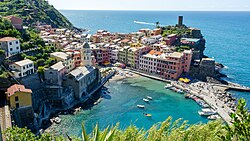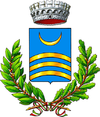Vernazza
| Vernazza | ||
|---|---|---|
| Comune | ||
| Comune di Vernazza | ||
 |
||
|
||
| Location of Vernazza in Italy | ||
| Coordinates: 44°08′N 09°41′E / 44.133°N 9.683°ECoordinates: 44°08′N 09°41′E / 44.133°N 9.683°E | ||
| Country | Italy | |
| Region | Liguria | |
| Province / Metropolitan city | La Spezia (SP) | |
| Frazioni | Corniglia, Prevo | |
| Government | ||
| • Mayor | Gerolamo Leonardini | |
| Area | ||
| • Total | 12 km2 (5 sq mi) | |
| Elevation | 0 m (0 ft) | |
| Population (December 31, 2007) | ||
| • Total | 1,001 | |
| • Density | 83/km2 (220/sq mi) | |
| Demonym(s) | Vernazzesi | |
| Time zone | CET (UTC+1) | |
| • Summer (DST) | CEST (UTC+2) | |
| Postal code | 19018 | |
| Dialing code | 0187 | |
| Patron saint | St. Margaret of Antiochia | |
| Saint day | July 20 | |
| Website | Official website | |
Vernazza (Latin: Vulnetia) is a town and comune located in the province of La Spezia, Liguria, northwestern Italy. It is one of the five towns that make up the Cinque Terre region. Vernazza is the fourth town heading north, has no car traffic, and remains one of the truest "fishing villages" on the Italian Riviera. It is the only natural port of Cinque Terre and is famous for its elegant houses.
Vernazza's name is derived from the Latin adjective verna, meaning "native". The aptly named indigenous wine, vernaccia ("local" or "ours"), helped give birth to the village's moniker.
The first records recognizing Vernazza as a fortified town date to 1080. Referred to as an active maritime base of the Obertenghi, a family of Italian nobility, it was a likely point of departure for naval forces in defence of pirates.
Over the next two centuries, Vernazza was vital in Genova's conquest of Liguria, providing port, fleet, and soldiers. In 1209, approximately 90 of the most powerful families of Vernazza pledged their allegiance to the republic of Genova.
The first documented presence of a church dates to 1251, with the parish of San Pietro cited in 1267. Reference to the Church of Santa Margherita d'Antiochia of Vernazza occurs in 1318. Some scholars are of the opinion, due to the use of materials and mode of construction, that the actual creation of the Church of Santa Margherita d'Antiochia took place earlier, some time in the 12th century. The Church of Santa Margherita d'Antiochia was expanded upon and renovated over the course of the 16th and 17th centuries, and thereafter was erected the octagonal bell tower that rises from the apse.
In the 15th century, Vernazza focused its defence against the dreadful and regularly occurring pirate raids, erecting a fortifying wall. In the mid-17th century, like many of the Cinque Terre villages, Vernazza suffered a period of decline that negatively affected wine production, and prolonged the construction of the trail system and harbour molo (mole constructed to protect against heavy seas).
In the 19th century, after a long period of stagnation, Vernazza returned to wine production, enlarging and creating new terraced hillsides. The result was a revitalisation of Vernazza's commerce. Also at this time, the construction of the Genova–La Spezia rail line began, putting an end to Vernazza's long isolation. The population of Vernazza increased by 60% as a result. Meanwhile, the construction of La Spezia's naval base also proved important to Vernazza in providing employment for many members of the community.
...
Wikipedia


